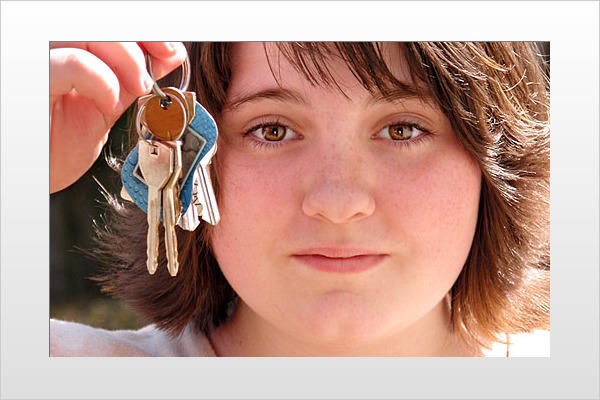
New drivers, most of whom are adolescents, have but one word for driver's education: Boring.
"It's some stupid thing my mom made me do," said 15-year-old Cary Smith of Seal Beach, California. "Classes two times a week for, like, two months.... It's really basic, lame stuff."
Scare-tactic approaches, dated materials, dull instructors...the stereotypical driver's ed class has students rolling their eyes even before they start. They've heard from their peers what they're in for: sitting in a room for hours after school or on weekends, watching the gruesome Red Asphalt movie, learning rules so basic that they elicit, "Well, duh!"
Now offer kids like Cary the chance to take their driver's ed class from the cozy comfort of their own computer. Add the power of computer animation, music and video and allow them to take breaks whenever they choose, then make the whole course doable in less than half the time.
Voilà! An industry is born.
That's what Gary Tsifrin, cofounder and COO of DriversEd.com is counting on. Together with his father, CEO Isaak Tsifrin, who has owned a driving and traffic school for 20 years, and CTO Gary Golduber, Gary Tsifrin developed a Web-based, state-specific curriculum that allows would-be drivers to complete the "classroom" or "knowledge" portion of their driver's education online. Lessons feature flash video, interactive 3-D traffic situations and case studies and DMV practice tests.
At the end of the DriversEd.com course, students receive a Certificate of Completion to take to the DMV. Once there, they can take their written exam, required for a driver's permit (or license, depending on the state). Over 15 states have certified that completing the DriversEd.com course will satisfy their Department of Motor Vehicles requirements. More states may follow.
The number of companies teaching driver's ed outside the classroom is small but growing. Some, like GoLocal.Net, offer a basic online study guide free of charge. Others, like TeenDriversEducation.com, offer to mail students a home study course, whereas sites like TeenDrivingCourse.com offer both online and home study, but are specific to California. Prices are generally $75-$100, which is very competitive with in-class programs.
The market potential is substantial. Millions of teens are licensed annually; the majority of them were required to take driver's ed. As each year goes by, there's a completely new customer base to draw on.
No More Wasted Time
Just as online traffic schools save thousands of ticketed drivers the hassle of attending school in person, online driver's ed programs save time. For the Internet-savvy teenager, it's a no-brainer.
"Friends did it and told me it was a lot easier than going to the actual classes. It doesn't take as much time and you get the exact same information," said Gregory Nussen from Santa Monica, California.
Fifteen-year-old student Drew Reed took the traditional route, which in California means 30 hours of classroom instruction. There was barely any teacher-student interaction. Instead, the instructor handed out the state driver's manual and supervised quizzes at the end of each chapter, whenever students were ready. Talking during class, playing cards and listening to music were all OK. Because the content was so basic, Reed felt the classes were overkill.
"Maybe 10 percent of the 30 hours was movies. Some of it was just cheesy state-produced fare in which some kid almost loses his license and has to relearn the traffic laws, blah blah blah," he said.
"They also showed a taped version of a TV special called 'World's Worst Car Crashes' which was funny, but not very educational since the mistakes people made were exceedingly stupid, like stopping in the middle of a freeway and getting rammed by a car at 70 mph."
Many of Tsifrin's customers are trying to save time, he says, because they're overachievers — busy from early morning 'til night with sports, advanced classes and extracurricular activities. An online program lets them fit in their driver's ed coursework whenever and wherever they like — home, school or public library. A unique feature of DriversEd.com is that it even allows students to download the DMV practice tests onto their Smartphone's, which they carry wherever they go.
Time is also a big issue for parents, who have to juggle their own commitments in order to ferry their child back and forth to driver's ed classes. Back in their day, public schools held most of the responsibility for delivering driver's ed classes. But their lack of proven effectiveness along with school district budget cuts has largely eliminated school-sponsored classes in recent years. Commercial driving schools — often mom-and-pop operations — have filled much of the gap, but these programs are often too difficult to reach for families in remote locations. As a result, Tsifrin says, kids from rural areas make up a disproportionate number of his customer base.
There are some downsides to taking driver's ed online. Students miss the chance to learn from the personal experiences of not only the instructor, but their peers as well, says William E. Van Tassel, Ph.D., manager of driver training operations for the American Automobile Association's (AAA) national office. Van Tassel feels that personal interaction is a critical component of the learning process. Online courses are a good supplement for classroom instruction, he says, but shouldn't be used to replace them.
Procrastination is another issue. The self-paced classes are designed to be completed in a few hours, at the students' convenience. But those hours can drag out into weeks or longer if self-discipline becomes an issue.
There are no national standards for driver's education, although much of the basic road rules are common among the states. Some larger companies like, AAA have begun to use their own standardized curriculum called "License to Learn" so that their classes remain consistent throughout the country.
Perhaps that will keep so many eyes from rolling.